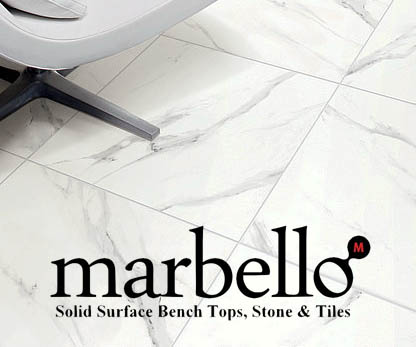Maintenance of Marbello Granite
By following these instructions, you are making sure that your investment is protected for many years to come.
By following these instructions, you are making sure that your investment is protected for many years to come.
Maintenance of Marbello Quartz
Quartz surfaces normally should not stain due to their low moisture absorption, however, avoid leaving spills to dry, instead, flush with water and wipe clean right away.
Avoid exposure to products with high pH levels such as oven cleaner and avoid exposure to paint strippers, paint removers, bleach and nail polish remover. If your benchtop surface has come in contact with the above, rinse immediately with clean water to neutralise the effect, and then follow usual cleaning procedure. Do not use bleach on or near a quartz surface.
Quartz surfaces normally should not stain due to their low moisture absorption, however, avoid leaving spills to dry, instead, flush with water and wipe clean right away.
Avoid exposure to products with high pH levels such as oven cleaner and avoid exposure to paint strippers, paint removers, bleach and nail polish remover. If your benchtop surface has come in contact with the above, rinse immediately with clean water to neutralise the effect, and then follow usual cleaning procedure. Do not use bleach on or near a quartz surface.
Acrylic Care and Maintenance
In most cases, Marbello acrylic can easily be repaired, however, following these guidelines will prevent any permanent damage.
Acrylic surfaces can be maintained effortlessly by wiping with warm soapy water. Use the same concentration as you would for standard dishwashing. Buff with a dry towel to avoid smearing. Ammonia based cleansers can be used sparingly to achieve a glossier finish or to restore shine if desired.
Experience has shown that a film builds up on the surface if water is left to dry on the benchtop. This film will dull the look of it, making the finish appear blotchy and uneven. To prevent this from happening, it is very important to wipe the benchtop completely dry after spills and cleaning.
In most cases, Marbello acrylic can easily be repaired, however, following these guidelines will prevent any permanent damage.
Acrylic surfaces can be maintained effortlessly by wiping with warm soapy water. Use the same concentration as you would for standard dishwashing. Buff with a dry towel to avoid smearing. Ammonia based cleansers can be used sparingly to achieve a glossier finish or to restore shine if desired.
Experience has shown that a film builds up on the surface if water is left to dry on the benchtop. This film will dull the look of it, making the finish appear blotchy and uneven. To prevent this from happening, it is very important to wipe the benchtop completely dry after spills and cleaning.

